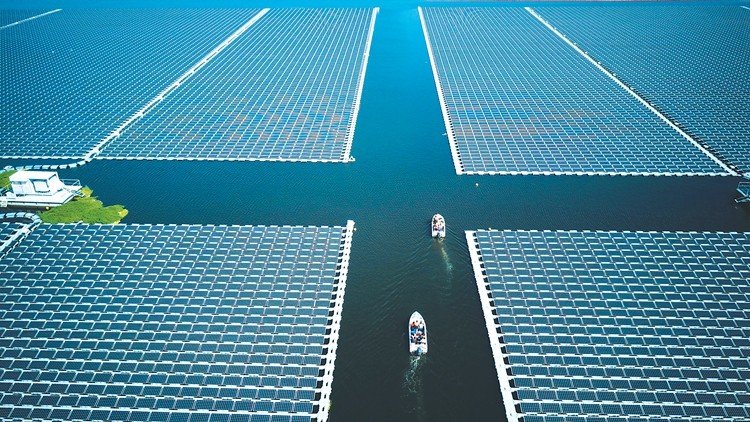The HG14 offshore photovoltaic project of Guohua Investment Shandong Branch is the first photovoltaic project in China to use a large offshore steel truss platform fixed pile foundation. Since the construction of the offshore part of the project began in early July, the sea has become lively. By the end of this year, 2,934 photovoltaic platforms will be laid on this 1,223-hectare sea surface, dressing the sea in bright clothes.

The HG14 offshore photovoltaic project is the first gigawatt-level offshore photovoltaic project in the country to enter the implementation stage. The project plans to invest about 8 billion yuan, with a planned installed capacity of 1,000MW. It adopts a block power generation and centralized grid connection scheme. After the submarine cable lands, it will be transferred to the land cable to connect to the newly built 220kV onshore booster station, and a supporting energy storage station will be built. It is the first photovoltaic project in China to use a large offshore steel truss platform fixed pile foundation. The project adopts a three-dimensional comprehensive development and utilization model of bottom aquaculture and photovoltaic construction to achieve mutual integration and complementarity between fishery aquaculture and photovoltaic power generation. After completion, it is expected that in addition to the income from photovoltaic power generation, the annual income from fishery aquaculture can reach more than 27 million yuan, effectively improving the spatial utilization rate and overall development income of the sea area. After the project is put into operation, it is expected to generate 1.78 billion kWh of electricity annually, effectively saving 594,500 tons of standard coal and reducing carbon dioxide emissions by 1.441 million tons, providing strong support for promoting the optimization and upgrading of the city’s energy structure.
It is not easy to make photovoltaic panels settle down at sea. Wind and waves, sea ice, ocean currents, etc. are all great challenges, and the test of the “chassis” of photovoltaic projects is particularly great. “We cooperated with the East China Survey and Design Institute to overcome the key technologies of large-scale offshore photovoltaics and solve the scientific research problems such as easy corrosion, ice impact, strong wind destruction, and water erosion of offshore photovoltaic facilities. The platform foundation structure adopts steel pipe piles with high structural strength, which can effectively resist the impact of ice, etc.” Zhou Zhongyu introduced.

So, under the support of a 60-meter-long and 35-meter-wide steel platform, photovoltaic platforms composed of monocrystalline silicon photovoltaic modules were steadily laid on the sea. “The entire project is expected to use more than 2.31 million monocrystalline silicon photovoltaic modules.” Zhou Zhongyu introduced. Invest 100 million yuan in special scientific research funds, plan to apply for 21 invention patents, and blaze a trail for the construction of photovoltaic projects in my country’s high-latitude icy sea areas.
It is understood that this is the first three-dimensional offshore photovoltaic project approved by the State Council in the province. “While realizing offshore photovoltaic power generation, the next step is to carry out shellfish bottom seeding in the waters of the photovoltaic field to explore a new model of integrated fish-light development.” Zhou Zhongyu said. Preliminary estimates show that after the project is fully completed and put into production, the annual output value can reach 700 million yuan.
Not far from the HG14 offshore photovoltaic project, the saline-alkali tidal flats of Laoshiwu Village, Kenli District, Dongying City have put on “new clothes” – under the endless deep blue photovoltaic panels, sea cucumbers, shrimps and crabs are growing healthily. As the largest single-capacity fish-light complementary photovoltaic project in Shandong Province, the China Resources Financial Hongguang Fishery 800MW photovoltaic power generation project was built in eight phases, and the project was fully connected to the grid in July last year.

At the project site, photovoltaic panels face the sun. “These photovoltaic panels can adjust their angles by 45 degrees to the direction of the sun, just like sunflowers, which increases the power generation to a certain extent,” said Zhang Liqiang, director of the 800MW photovoltaic power station of China Resources Financial Hongguang Fishery. At the same time, photovoltaic panels can also provide a place for sea cucumbers in the breeding ponds to cool down, just like parasols, achieving a win-win situation for power generation and breeding.

